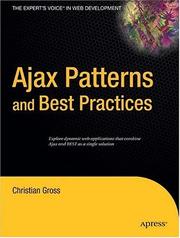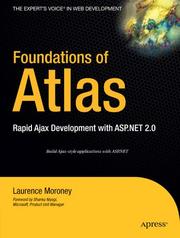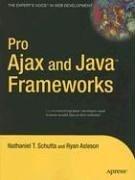| Listing 1 - 4 of 4 |
Sort by
|

ISBN: 128070070X 9786610700707 1430201312 1590596161 Year: 2006 Publisher: Berkeley, CA : Apress,
Abstract | Keywords | Export | Availability | Bookmark
 Loading...
Loading...Choose an application
- Reference Manager
- EndNote
- RefWorks (Direct export to RefWorks)
Ajax is taking us into the next generation of web applications. Ajax has broken the client-server barrier by decoupling the client from the server, but an Ajax application still needs a server to extract content from. The most effective use of Ajax and the server requires an understanding of REST, an architectural style used to define Web services. Ajax Patterns and Best Practices explores dynamic web applications that combine Ajax and REST as a single solution. A major advantage of REST is that, like Ajax, it can be used with today's existing technologies. This is an ideal book whether or not you have already created an Ajax application. Because the book outlines various patterns and best practices, you can quickly check and verify that you're building an efficient Ajax application. Inside the book, the patterns will answer the following questions: What is Ajax, and REST, and why do you even care? And if I should care what are some examples of websites that make effective use of Ajax and REST? What are the absolute basics of Ajax and REST and what parts of those basics should I use? How should deal with large amounts of data? Should I cache the data? Should I get the data piece fed to me? (Patterns: Cache Controller, and Infinite Data) People keep telling me that sessions and cookies are bad? Are they bad? What should I do? And while I think about how about generating content for other devices? (Permutations pattern) I want to fix the back-button problem of the HTML browser. (State Navigation pattern) What is the best way to create a mashup? (REST Based Model View Controller pattern) My page has so many links managed by JavaScript, and I am losing control, help me make this more organized! (Decoupled Navigation pattern) I understand that HTTP means I send data to the server, how about the server sending me some data without asking for it? (Persistent Communications pattern) My server side code looks like a mess with tags and code pieces everywhere. How can I organize and make my HTML page behave like a SOA client and use REST based web services? (Content chunking pattern).
Ajax (Web site development technology) --- JavaScript (Computer program language) --- Asynchronous transfer mode. --- World Wide Web. --- W3 (World Wide Web) --- Web (World Wide Web) --- World Wide Web (Information retrieval system) --- WWW (World Wide Web) --- Hypertext systems --- Multimedia systems --- Internet --- ATM (Data transmission) --- Broadband communication systems --- Packet switching (Data transmission) --- Domain-specific programming languages --- Object-oriented programming languages --- Scripting languages (Computer science) --- Asynchronous JavaScript and XML --- Web site development --- Information Technology --- Computer Science (Hardware & Networks) --- General and Others --- Computer programming. --- Software engineering. --- Web Development. --- Software Engineering/Programming and Operating Systems. --- Computer software engineering --- Engineering --- Computers --- Electronic computer programming --- Electronic data processing --- Electronic digital computers --- Programming (Electronic computers) --- Coding theory --- Programming

ISBN: 128072689X 9786610726899 1430201754 1590596471 Year: 2006 Publisher: [Berkeley, CA] : New York, NY : Apress ; Distributed to the Book trade worldwide by Springer-Verlag New York,
Abstract | Keywords | Export | Availability | Bookmark
 Loading...
Loading...Choose an application
- Reference Manager
- EndNote
- RefWorks (Direct export to RefWorks)
This book introduces a fast-track path to understanding Atlas, and how this technology can increase the power and functionality of your code while conserving time and effort. The book begins with a bare-bones introduction that explains how Atlas relates to Ajax. Microsoft Atlas is a web-client framework that makes building Ajax-style applications easier. It provides a prewritten framework that gives you a structured environment in which to work. Atlas also provides you with an object model and standardized debugging to make development faster and simpler. Ajax is a way of combining a number of Web technologies including JavaScript, dynamic HTML, and a feature known as XMLHttp (which reduces the need for client browsers to constantly reconnect to the server every time new information is downloaded). But at the moment, people developing with Ajax have to write their code from the ground up, which is complex and time consuming. The book guides you through a series of practical examples that demonstrate the Atlas framework and available controls. After reading this book, youll be able to compile a seamless Atlas-based application of your own! In anticipation of changes during development of the Atlas technology, the updated source code is posted for download on the author's blog, www.philotic.com/blog. This book demystifies the Atlas technology and shows you how to work with it. The first book dedicated to this revolutionary new technology. Written by an experienced .NET author in collaboration with the Atlas development team.
JavaScript (Computer program language) --- Asynchronous transfer mode. --- World Wide Web. --- Microsoft .NET. --- Active server pages. --- ASP (Computer file) --- W3 (World Wide Web) --- Web (World Wide Web) --- World Wide Web (Information retrieval system) --- WWW (World Wide Web) --- Hypertext systems --- Multimedia systems --- Internet --- ATM (Data transmission) --- Broadband communication systems --- Packet switching (Data transmission) --- Domain-specific programming languages --- Object-oriented programming languages --- Scripting languages (Computer science) --- Dot Net (Software framework) --- Microsoft .NET --- Microsoft .NET software framework --- .NET Framework --- Information Technology --- Computer Science (Hardware & Networks) --- Software engineering. --- Software Engineering/Programming and Operating Systems. --- Computer software engineering --- Engineering

ISBN: 128072692X 9786610726929 1430201827 1590596773 Year: 2006 Publisher: Berkeley, CA : Apress,
Abstract | Keywords | Export | Availability | Bookmark
 Loading...
Loading...Choose an application
- Reference Manager
- EndNote
- RefWorks (Direct export to RefWorks)
As a Java developer, you want a guide that shows you how to add Ajax functionality to your web applications with a minimum of effort. Look no further than Pro Ajax and Java Frameworks! In this book, recognized Java experts and authors of the bestselling Apress title Foundations of Ajax will show you how. The authors begin by recapping Ajax basics. Then they unveil a comprehensive Java/Ajax toolkit. Tools include JSEclipse for code editing, Venkman for JavaScript debugging, and Dojo Compressor for code compression. They also explain Log4js (and other tools) for JavaScript logging, JsUnit (and others) for testing, and various libraries like AjaxTags, DWR, and Script.aculo.us for rapid code development. The last part of the book shows you how to build up a series of professional Java/Ajax applications. These will incorporate some of today's most popular frameworksSpring, JSF, Struts, and Tapestry, giving you all you need to incorporate Ajax into your everyday work and become an Ajax expert!
Ajax (Web site development technology) --- JavaScript (Computer program language) --- Web site development. --- Asynchronous transfer mode. --- ATM (Data transmission) --- Broadband communication systems --- Packet switching (Data transmission) --- Development of Web sites --- Web sites --- Internet programming --- Domain-specific programming languages --- Object-oriented programming languages --- Scripting languages (Computer science) --- Asynchronous JavaScript and XML --- Web site development --- Development --- Information Technology --- Computer Science (Hardware & Networks) --- Java (Computer program language). --- Computer science. --- Software engineering. --- Java. --- Computer Applications. --- Software Engineering/Programming and Operating Systems. --- Computer software engineering --- Engineering --- Informatics --- Science --- JavaSpaces technology --- Application software. --- Application computer programs --- Application computer software --- Applications software --- Apps (Computer software) --- Computer software
Book
ISBN: 1281141631 9786611141639 1430202246 Year: 2006 Publisher: Berkeley : New York : Apress ; Distributed to the Book trade worldwide by Springer-Verlag,
Abstract | Keywords | Export | Availability | Bookmark
 Loading...
Loading...Choose an application
- Reference Manager
- EndNote
- RefWorks (Direct export to RefWorks)
Until recently, building interactive web-based mapping applications has been a cumbersome affair. This changed when Google released its powerful Maps API. Beginning Google Maps Applications with PHP and Ajax was written to help you take advantage of this technology in your own endeavorswhether you're an enthusiast playing for fun or a professional building for profit. This book covers version 2 of the API, including Google's new Geocoding service. Authors Jeffrey Sambells, Cameron Turner, and Michael Purvis get rolling with examples that require hardly any code at all, but you'll quickly become acquainted with many facets of the Maps API. They demonstrate powerful methods for simultaneously plotting large data sets, creating your own map overlays, and harvesting and geocoding sets of addresses. You'll see how to set up alternative tile sets and where to access imagery to use for them. The authors even show you how to build your own geocoder from scratch, for those high-volume batch jobs. As well as providing hands-on examples of real mapping projects, this book supplies a complete reference for the Maps API, along with the relevant aspects of JavaScript, CSS, PHP, and SQL. Visit the authors' website for additional tips and advice.
Ajax (Web site development technology) --- Web sites --- Asynchronous transfer mode. --- PHP (Computer program language) --- JavaScript (Computer program language) --- Application software --- Authoring programs. --- Development. --- Development of application software --- Domain-specific programming languages --- Object-oriented programming languages --- Scripting languages (Computer science) --- Personal Home Page (Computer program language) --- Programming languages (Electronic computers) --- ATM (Data transmission) --- Broadband communication systems --- Packet switching (Data transmission) --- Asynchronous JavaScript and XML --- Web site development --- Authoring programs for Web sites --- Design --- Computer programs --- Software --- Software engineering. --- Software Engineering/Programming and Operating Systems. --- Computer software engineering --- Engineering
| Listing 1 - 4 of 4 |
Sort by
|

 Search
Search Feedback
Feedback About UniCat
About UniCat  Help
Help News
News